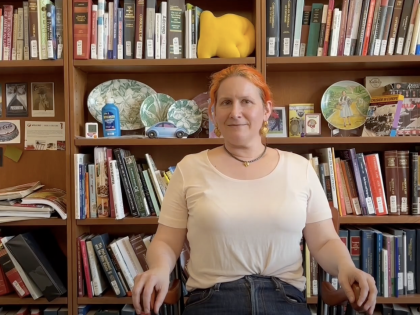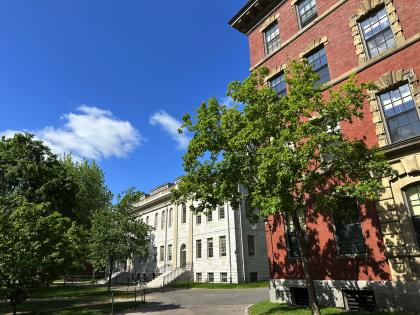On a Tuesday in late July, as the last few students filter in from the evening swelter to a basement classroom in the Carpenter Center, John Stilgoe, the Orchard professor in the history of landscape—and as unique a figure as there is on the Harvard faculty—begins his lecture with a digression.
It’s the fifth week of a seven-week summer session, and the class is called “Scrutinizing the American Environment: The Art, Craft, and Serendipity of Acute Observation.”
“I want to tell you—,” Stilgoe says, pacing slightly and stifling a cough with a sip of Coca-Cola. A dozen or so students have spread out across the cavernous classroom. Stilgoe continues: “You know that little green character—I’ve ordered one online—called Gumby?” Tentative nods from the class; they know he’s going somewhere with this, but it’s not clear where. “Well, I want to tell you how Gumby got his name.” Then he launches into a tale of his morning in Widener Library, searching the maps and charts collection for a now-flooded island that once stood off the coast of Louisiana—its name: Gumby Island—and proceeds without pause into the biography of animator Art Clokey, abused and orphaned as a boy, who grew up spending summers on his foster grandfather’s farm in Iowa, a place covered in “gumby” soil. “Which is a clay soil that’s very hard to work,” Stilgoe explains. “When it’s dry it’s like rock, and when it’s wet it’s like slime.” But: “You could shape it and let it dry and it would take different forms.” Like, for instance, that of a little green slant-bodied man. Clokey, of course, was Gumby’s creator.
As that revelation sinks in, Stilgoe ranges still further, from Gumby and gumby to gumbo (which is not a “stew,” he teasingly corrects one student) and its variant gombo, a word (probably originally Congolese) that in Creole means “okra.” And now he’s back in Louisiana and colonial New Orleans, talking about a flour made from dried and beaten sassafras leaves, which the Native Americans brought to trade with the newly arrived French in the early years of the Crescent City. That flour later became an ingredient in gumbo (“Reading backwards through the cookbooks, you realize that you can’t make gumbo without it”), a food that is itself deeply tied up with the creation of jazz and modern American dance. Finally Stilgoe draws breath. “You see, I was just trying to figure out,” he says, “if you say ‘Gumby’ to anybody in America, what does it mean?…These are wonderful words—Gumby, gombo, gumbo—and they have connections to places, food, all through the Mississippi basin, to Creole English, French, and Spanish. And in the middle of it is this little animated figure.”
A pause. “Anyway,” Stilgoe says, “you might as well know what I’m doing as a research scholar, even if it sounds nutty.”
Then, striding to the back of the room, he turns out the lights and fires up the slide projector for the evening’s planned lesson. And class begins, again.
THE THING IS, though: in this course there’s maybe no such thing as a digression. Like almost all of Stilgoe’s classes, this one is fundamentally about noticing things, especially things that seem random and ordinary, and then probing deeper to find out how they might be neither. It’s about paying attention and following where that attention leads—like from Gumby to gumby to gumbo to gombo. In the syllabus, Stilgoe lays it out this way: “In an age dominated by programmed, mediated material, especially that based on the Internet,” he writes, “looking at real things becomes more difficult yet perhaps far more important. Just looking around is a skill based on valuing visual acuity directed at things most people overlook.”
A historian (though that doesn’t even begin to cover it), Stilgoe’s expertise is the built environment, in all its elements and aspects, and that’s what he has taught in the department of visual and environmental studies since 1977. His classes are some of the most popular on campus. For this one, he has students reading four books: Situation in Flushing, Edmund Love’s 1965 memoir of his Michigan hometown; Harmony: A New Way of Looking at Our World, in which Prince Charles (yes, that one) gives a close reading of modern industrialization and the various disharmonies it has wrought worldwide; plus Stilgoe’s own Train Time: Railroads and the Imminent Reshaping of the United States Landscape and What is Landscape? a 2015 addition to his oeuvre exploring the etymology of the built “landscape”—or “shoveled land,” as the literal translation from the Old Frisian “landschop” reads—all around us.
But this evening’s lesson is as much about doing as seeing. Back at the lectern, Stilgoe presses a button on his clicker and an image appears on the screen: the cover of a book from 1957 called Thinking with a Pencil. “It’s about how to make drawings that aren’t really art,” he explains: maps, graphs, plans, illustrations; color, shading, perspective, shape. He notes that interest in sketching exploded after World War II (probably, he reckons, because soldiers in every army had carried sketchbooks and pencils to fill their idle hours). “I don’t want you to think about this in detail,” he tells the class, “but I just want you to realize that in this period”—the postwar era—“there was another kind of drawing taught in public schools: mechanical drawing in shop class.” Schoolboys, including Stilgoe, learned how to draw with a triangle and a T-square; they learned to make sketches of things that could be built. “And we were taught all of this mechanically, not freehand. And it had nothing to do with us displaying our inner emotions or anything.”
THIS BRINGS Stilgoe to the evening’s theme: “shop theory”—which, as he puts it, is “how you actually make something,” the tools, techniques, skills, and equipment needed for sewing a skirt from a pattern, or repairing a boat, or fixing an engine, or plowing a field, or building a bookcase. Shop theory is more about efficiency and competence than artistry. And like mechanical drawing, Stilgoe adds, it was once taught in schools, before television and video games and the Internet, and before the American education system abandoned the idea of shop class. Decades ago, boys were given toolkits for specific building projects, like putting together a small sailboat, which they might do in an afternoon. Newlyweds received sets of tools to carry them through their domestic life.
First and foremost in shop theory, Stilgoe says, is the importance of having the right tools. And of the right quality. For the next hour or more, as images stream out of his slide projector—photographs of tools; glossy advertisements for them; pages from the how-to booklets and terminology guides that some manufacturers still include with their products—he narrates a series of hand tools and their uses like a story.
Here is a Coes screw wrench (“Most of you probably call it a monkey wrench”), manufactured in Worcester, Massachusetts, beginning in the late 1800s. The steel-handled ones were for use indoors; those with wood cheeks on their handles were used outdoors, by men working barehanded. The largest Coes wrenches, standing six feet tall, were carried in the toolboxes of steam locomotives, to tighten the enormous nuts on train axles in an emergency.
And here is a Lenox sawblade (also from Massachusetts), “probably the best in the world.” And here, a Milwaukee Sawzall reciprocating saw. “A Milwaukee Sawzall, goggles, and Lenox blades—you can do an awful lot of things to your house once you have invested in those tools,” Stilgoe says. But most people don’t.
A young woman raises her hand to ask why. “Is it that people don’t want to invest in these tools, or that they know they won’t use them more than once?”
“I think the bottom line,” Stilgoe answers, “is that many people think they’re not going to use the tool again. But it’s my belief that what Homer says in The Iliad is right: he says, ‘The sword incites itself to violence.’ In other words, if you give someone a weapon, they’re likely to use it.…And a tool incites to use. If you have a tool, you kind of look around and see what else you want to do with it.” Again, he’s back to noticing the landscape. And to doing. “If you’re tinkering with tools, if you’re doing something kind of minor,” Stilgoe tells the class, “then you get to know the tool a little bit. You get comfortable with it.”
There’s a sense of loss that suffuses even the most practical, almost technical, moments in Stilgoe’s lecture. When he’s explaining to students how a screw wrench works or what a lathe is, he’s telling them things that their peers a generation or two ago would likely have known already. “I don’t ever mean to suggest that I blame you for what you don’t know,” he assures them at one point. “I don’t know an enormous amount of stuff, too.…But you should think about not only what you guys don’t know, but why you don’t know it.” They’re bereft, he means, not just of useful knowledge, but of some measure of beauty too. These hand tools are beautiful, Stilgoe says. They’re pleasing not just because they are powerful and efficient, but because of their shape and balance and texture. And that pleasure carries over to the work that can be done with them. “This is the way many Americans express their desire for beauty,” he explains—by using tools to build things. “They work on their own house; they build a deck; they build pieces of furniture. And none of this stuff may ever be particularly well done, but it’s a personal creative expression of a person’s understanding of beauty.”
HE’S TALKING ABOUT himself too. Stilgoe salts his lecture with first-person accounts from his own tool-wielding adventures: the screened-in porch he built in 11 days one summer to soothe his then-wife’s worries about mosquitoes, the white-pine bookcase he’s building himself this summer, the hand-cranked contraption he made to paint the flagpole in his yard (“I do have to wear foul weather gear underneath it”)—and the flagpole itself is an old spar recovered from a ship that washed ashore in 1898. He tells the story of the New Year’s Eve when his twin sons, now grown, were seven years old, and his wife said wouldn’t it be nice if the three rooms in the middle of their house were one large room instead, and so Stilgoe and his sons that very night emptied the rooms of furniture, got a tractor out of the barn out back and, running steel cables through the windows, pulled down the partitions separating the rooms. “A great New Year’s Eve,” Stilgoe insists to shocked and skeptical students. “We finished at about four in the morning, the boys never forgot it, and the entire room was an enormous heap of rubble.”
And, of course: stories about the boats he’s built and repaired. A boatbuilder’s son from Norwell, Massachusetts, Stilgoe spends the warm weather months piloting a ship’s lifeboat that he converted into a sailboat. His shop at home is almost always occupied with some boat-repair project or another. Currently, he’s rehabilitating an antique rudder for his rowboat, a project he’ll return to tonight after he gets home. He can hardly wait.
A student raises his hand. “The word mechanics,” he says. “Today we think of someone who fixes cars.”
“Yes,” Stilgoe nods. “Fixes cars.”
“But 100 years ago, it meant a lot more than that.”
“Yes,” Stilgoe says, then slower, “yes. Although this is not where I intended to go.”
“I don’t mean to take you too far down the rabbit hole,” the student backtracks.
“No, no,” Stilgoe says. “This is the kind of thing—I mean, the word means something. And what’s happened to it is interesting.”
There are no digressions. That question leads to a discussion of the coming glorification—in advertisements and elsewhere—of handmade products, in a world where fewer people have expertise in the tools needed to make them, and where much of what surrounds Americans is generic and impersonal. The discussion lands on the contemporary culture of disposability.
A student raises her hand. “Living in a virtual world, where technology itself is constantly being replaced,” she asks, “do you think we’re throwing away more? Do we not know how to value things?” She seems almost shaken by her own question, as if the idea hadn’t fully occurred to her until after the words were already out of her mouth.
Yes, Stilgoe finally says. “I’m finding now that a lot of younger women don’t have mementos from their boyfriends. They don’t have love letters, because their boyfriends sent them emails.” This is another rabbit hole, but suddenly it seems to be where Stilgoe was headed all along. The room gets quieter. He tells the class about his mother, who died in 2001, and his father, dead four years before that, and the diaries they both kept. He hasn’t worked up the emotional fortitude to read them yet—he tried once, and there were too many tears—but they’re there. So are the letters that his mother and father wrote back and forth, sometimes daily, during World War II. Afterward, Stilgoe says, “My mother had them all tied together with ribbons in a box my father built.” He looks up at the class. “What are you going to have?”
Silence. And now Stilgoe is talking not only about love letters, but photos and furniture and books on shelves. “You’re going to figure out that the IKEA stuff isn’t what you want anymore,” he says. “And when you do, you should think about why. ‘Is it because I’m getting older?’ ‘Because I want a different look?’ ‘Because I want something with a past?’ I don’t know, but it’s coming for you, and that’s partly what this course is about.”
The discussion carries on for another 15 minutes, long enough for Stilgoe to show a few more slides and talk about tractors and farming techniques and machine tools in factories, but that moment remains crystallized. It leaves something hanging in the air, and when the class ends and Stilgoe sends his students back out into the heat, they gather their bookbags and shuffle out almost without sound.








